Underwater Basket Weaving —
I can't remember why I searched for "Underwater Basket Weaving" on wikipedia, but when I did I was surprised to discover that it's a real craft. I had frequently heard the phrase used in college as a joke to mean an easy class, and it always made me imagine people submerged in a swimming pool trying to weave a basket. I never thought it was something real. But turns out it is real.
Wikipedia defines it as:
a process of making wicker baskets which involves dipping reeds or stalks of plants into (or, as the name suggests, under) water and allowing them to soak. This process will provide a very supple and flexible reed which can then be woven into a basket given enough time. The baskets then will be allowed to dry and provide a sturdy container.
I'm assuming that Wikipedia's definition is correct. After all, it sounds reasonable. But it made me wonder how the term came to mean an easy class, and whether any colleges actually offer Underwater Basket Weaving.
The second question is the easiest to answer, since the Wikipedia article also states that: "The University of California, San Diego's recreation department first offered an underwater basket-weaving class in 1984. Saint Joseph's College in Indiana offers this class as well."
I want to verify that UCSD and St. Joseph's actually do offer such a course. But assuming they do, do any other colleges offer it? I'm not sure. All I can say is that I've never seen it listed in any college catalog. (Wikipedia links to an
Underwater Basket Weaving syllabus supposedly offered by the University of Portsmouth, but the syllabus reads like a joke, so I'm guessing it is a joke.)
The earliest reference to the term that I could find, searching on
Newspaper Archive, was May 9, 1960. The author of a
Pasadena Independent trivia column noted that "Son Herbert reports that underwater basket weaving is all the rage among college students who want to spare the brain cells." So evidently the joke had been well established by 1960. I would guess the origin of the term dates to the late 1950s. Did the joke start after a college actually began offering this course? I don't know, but it seems possible.

 The floor of this elevator, in Taiwan, is painted to look as if there is no floor, just the lift shaft.
The floor of this elevator, in Taiwan, is painted to look as if there is no floor, just the lift shaft. Banyan Tree Gets Police Protection
Banyan Tree Gets Police Protection









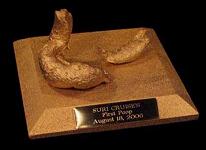 Daniel Edwards, creator of the controversial statue of Britney Spears giving birth on a bear-skin rug, has gone one step further with his new sculpture.
Daniel Edwards, creator of the controversial statue of Britney Spears giving birth on a bear-skin rug, has gone one step further with his new sculpture. 
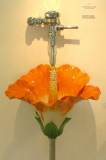


 The Guardian has a review of a new biography of the notorious art forger Han van Meegeren. The biography, by Frank Wynne, is titled I Was Vermeer: The Legend of the Forger who Swindled the Nazis. Van Meegeren, who was driven to a career in forgery by anger at being ignored by the art establishment, ended up becoming fantastically wealthy from his career in deception, before his downfall:
The Guardian has a review of a new biography of the notorious art forger Han van Meegeren. The biography, by Frank Wynne, is titled I Was Vermeer: The Legend of the Forger who Swindled the Nazis. Van Meegeren, who was driven to a career in forgery by anger at being ignored by the art establishment, ended up becoming fantastically wealthy from his career in deception, before his downfall: 
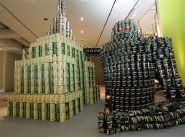
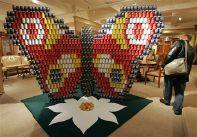
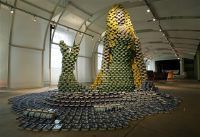






















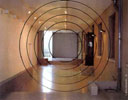



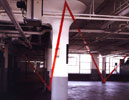

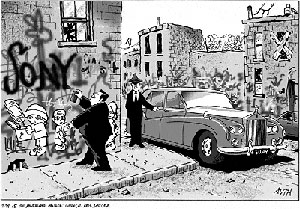
 I'm about five days late posting this, but better late than never. An advertisement for an "Extra Virgin Mary Statue" slipped by the editors of the conservative Catholic magazine, America. The advertisement offered "a stunning ... statue of the Virgin Mary standing atop a serpent wearing a delicate veil of latex." The "delicate veil of latex" was a blue condom. America's editors didn't examine the accompanying photo closely enough to realize this. And so the ad ran in the December 5 edition. People who contacted the seller were told the ad was meant "as an assault on Catholic faith and devotion." I don't know who the artist was who created the ad. Maybe it was Banksy.
I'm about five days late posting this, but better late than never. An advertisement for an "Extra Virgin Mary Statue" slipped by the editors of the conservative Catholic magazine, America. The advertisement offered "a stunning ... statue of the Virgin Mary standing atop a serpent wearing a delicate veil of latex." The "delicate veil of latex" was a blue condom. America's editors didn't examine the accompanying photo closely enough to realize this. And so the ad ran in the December 5 edition. People who contacted the seller were told the ad was meant "as an assault on Catholic faith and devotion." I don't know who the artist was who created the ad. Maybe it was Banksy.







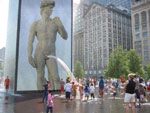
 The National Portrait Gallery has reported that the Grafton portrait, long thought to depict Shakespeare as a young man, doesn't depict him at all. They don't know who the guy in the painting is. The portrait apparently served as the inspiration for the portrayal of Shakespeare in the movie Shakespeare in Love.
The National Portrait Gallery has reported that the Grafton portrait, long thought to depict Shakespeare as a young man, doesn't depict him at all. They don't know who the guy in the painting is. The portrait apparently served as the inspiration for the portrayal of Shakespeare in the movie Shakespeare in Love.